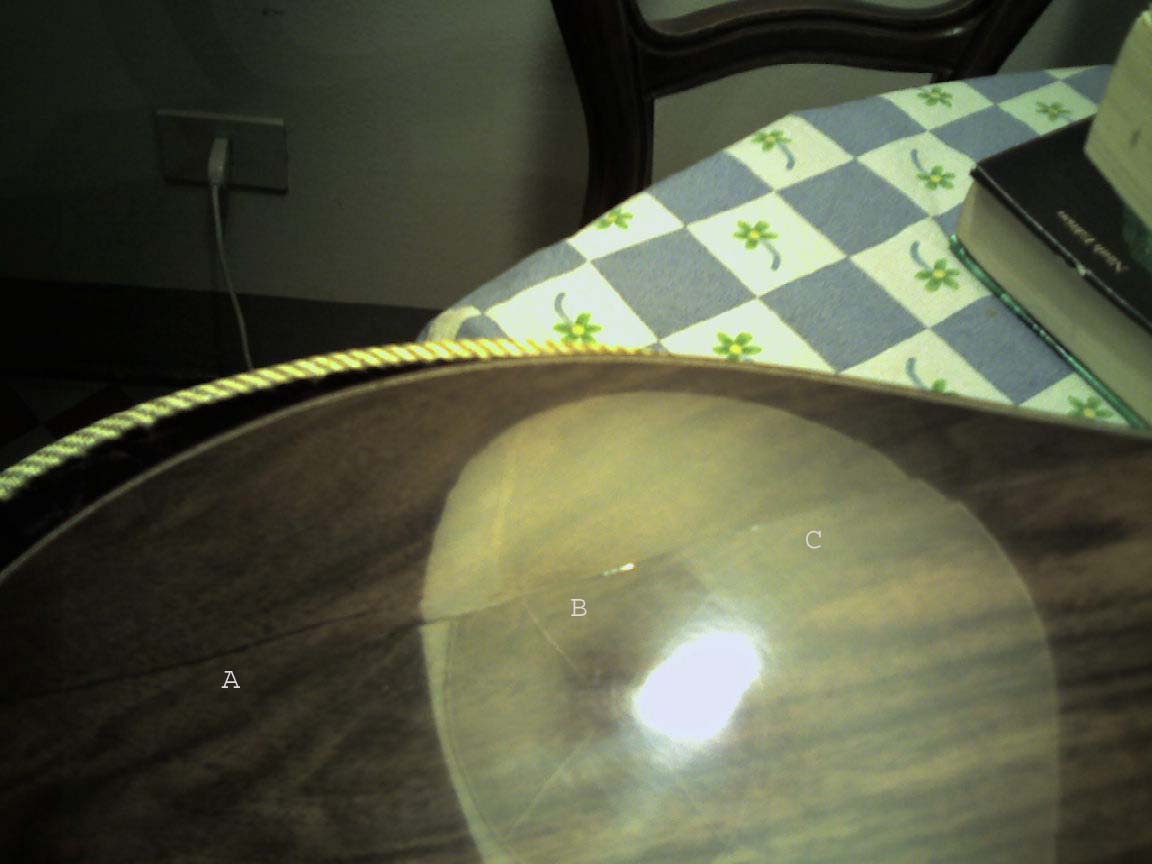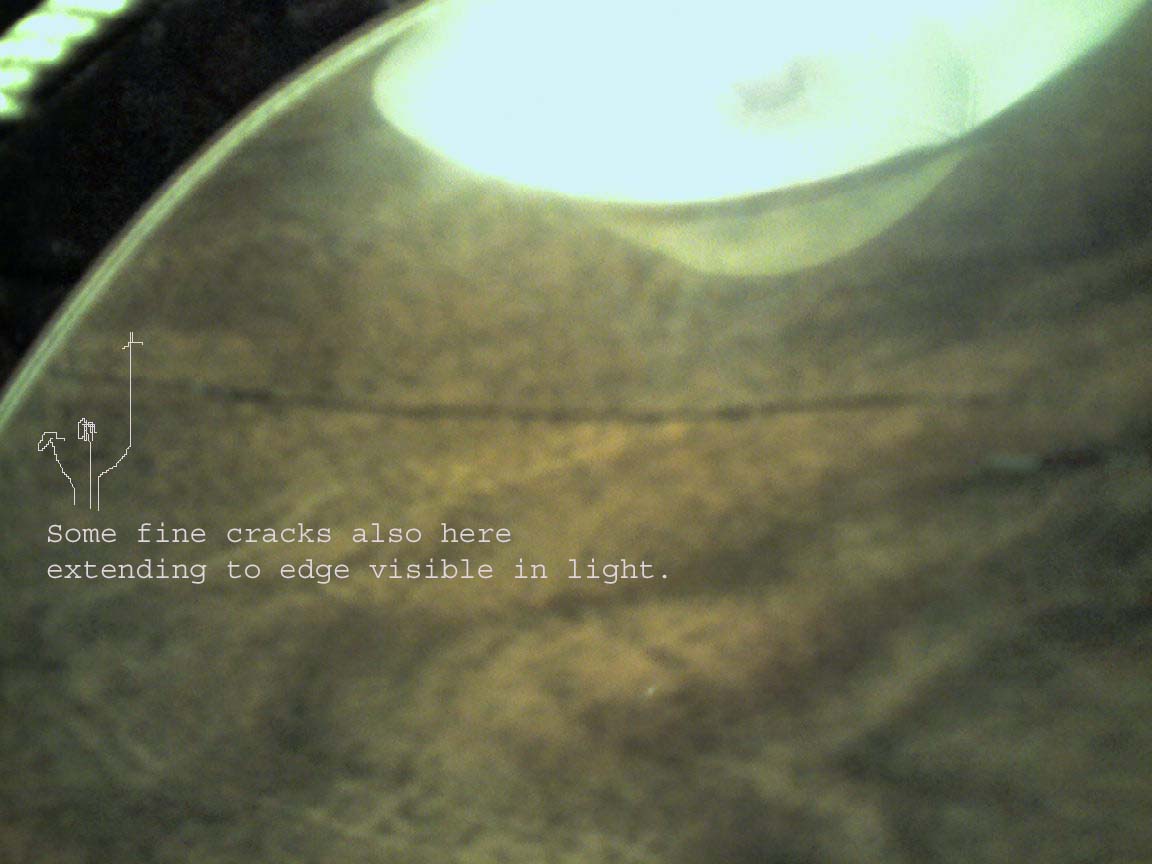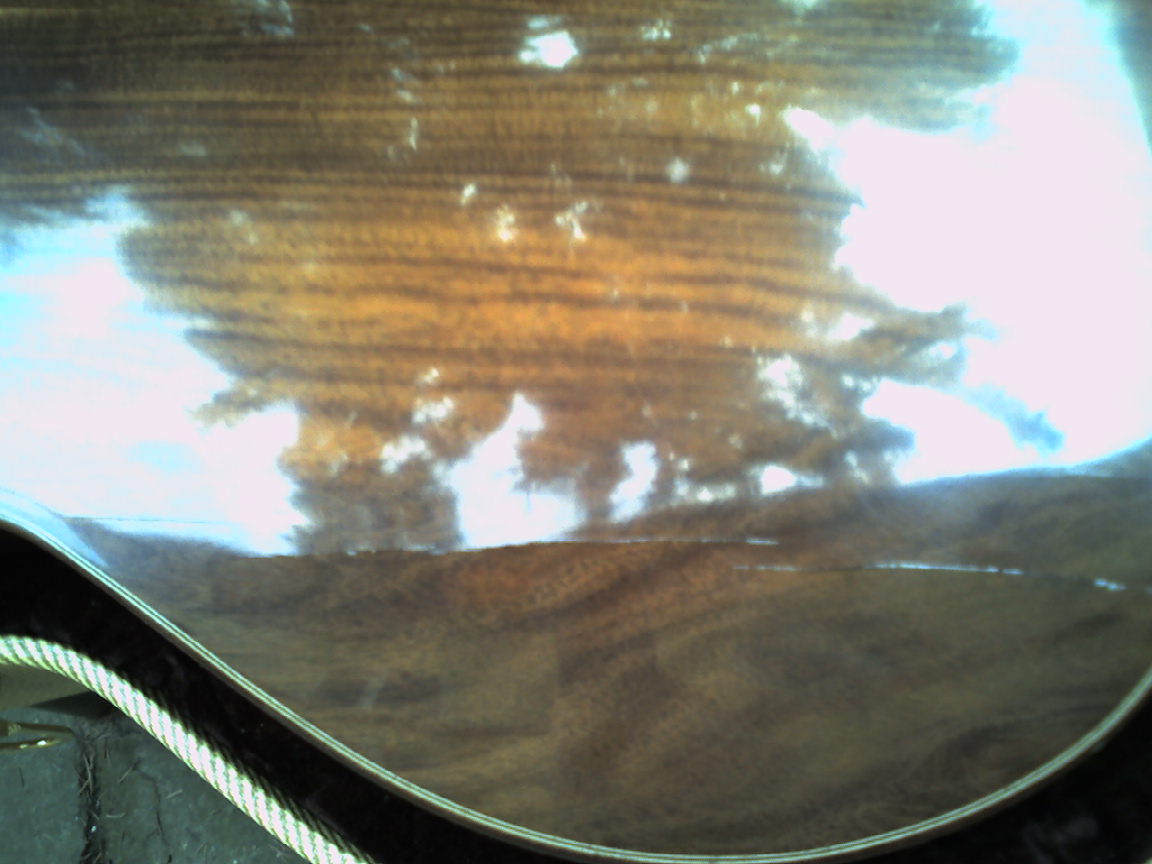The story:
Well, I have recently purchased a handbuilt luthier instrument from an "up and coming" luthier based in the States.
I was searching for something that only a luthier can provide in detail...intonation, separation, balance throughout the fretboard, proper tuning of soundboard, etc.... This oppty arose....
This all said, the top is a very high grade (if not the finest I have ever seen) cedar, back and sides are of a type of Southern Ebony. Does anyone notice what specific type? It is a lighter ebony. This was an experiment it seems which has gone quite awry.. The guitar also incorporates a soundport (a feature I like very much).
As this is guitar #7, I was sympathetic and accepting of minor flaws. The fellow is very knowledgeable, has a bright future (I still do feel), and is without question a person of integrity.
The reason for my mail is this:
Within a day or so of it's arrival, cracks appeared in the back. It extends up the left bout, extending upwards, skipping the center, and continues towards the top.
Needless to say, it ruined my day.
I have attached images forwarded to him in our discussion. The image against the sofa is an image he sent to me prior to finishing. I used it
to show him it existed prior to its arrival....
There was no argument, in fact, he knew what it was and why, which was both reassuring and a bit frustrating as I think of it now. He clearly knowing what I wanted in this thing....
It is a particularly heavy guitar. The heaviest I have ever held!! I feel as if I am carrying a tree trunk.
The sides are particularly thicker than normal. I havent the dimensions at the moment but he did forward them.
Apparently he was aware of Ebony's tendency to crack.
His explanation was thus, the finish applied was a thin urethane on the back and sides. (Lacquer he does not prefer due to shrinkage, and I agree. Although a standard traditionally, it is just that, a standard that has been used traditionally and continued to be used today without much merit. Gutiarists/musicians *hate* change dontcha know.)
The top was french polished with 2 very fine layers of urethane for protection. Good idea.
These cracks in the back appeared a day upon receipt.
3 of them as shown, are very large and do go all the way through and can be viewed from within.
There are other fine cracks noticeable within, and on the same lower left bout which do not go all the way through.
He had stated that what had occured was the shrinking of the finish as it cured caused this to become noticeable now.
*THAT IS* this "check" as he originally *did* make me aware of which existed and was repaired and he states is completely stable, has now revealed itself.
This "check" (the 2 large lines/cracks) can be viewed within the soundhole and go all the way through therefore. What the difference is between a
"check" and a "crack" illudes me.
Here is an excerpt of his past email:
"I wanted to discuss one issue with you, however. Before guitars are built, it is customary to fill all surface checks, holes, cracks, grain inconsistencies, etc. with CA glue (you can read more about this on any of
the guitar/luthier forums). There was an area on the back that I filled and is somewhat visible in the finished guitar. The surface check is in no way going to cause a problem structurally (as it was filled with very
strong material before the guitar was even built), but you can see the indentation in the urethane. Again, it is slight and can only be seen at a certain angle in a certain light. It is equivalent to gutiars where you
can see where the backstrip/perfling/binding meet the body of the guitar through the finish (the finish will settle on these areas differently than it sits on the rest of the guitar because of the glue/epoxy that is used
to hold them in place). The issue could be alleviated by adding more finish and sanding, but I did not want to lose the beauty of a thinner finish and risk sanding through the finish on the other areas of the guitar. If this occurred, the entire guitar would need to be refinished and very likely would not look as good as it does. I do not think this is a big deal, but wanted to let you know what was going on."
Basically I am in need of other opinions here....
Needless to say they scare the Hell out of me and is quite dramatic in appearance.
Again, these 3 large areas are *cracks* not "checks" as described. They go all the way through?!
And now are effecting the finish.
Should I have it repaired professionally, back replaced?? Will it continue to grow, etc..?
I know only what I have read. This I know can be dangerous.
As a note, he as usual wished to amend and satisfy, and has basically (due to the high cost of shipping from Italy/Georgia) allowed me to basically come out of this with a free guitar more or less...
This of course is *not* what I signed up for or expected.
I of course have not been willing to touch it since.
Florence, Italy is very humid. I am uncertain as to what else will occur.
The surface within does make an obvious felt change of direction.
One can also view on the exterior what appear to be stress cracks. Others seem to be developing on that same lower bout. Are they stress related? Is the wood flawed? Will the sound change in time?
As I was intending to (needing to) sell my Ramirez for this, should I merely sell it as a "Luthier Special" with the Ramirez and search for a second hand luthier instrument of note??
Im at a loss...The instrument is ok. I have not played it enough to make many judgements as I have just strung it up again today. There are some errs on the fretwork, finishing could have been better, some excess glue within, and I have today noticed an open 5th string buzz.
It occurs only at that frequency as playing 6th string 5th fret produces same buzz at bridge.
No it is not headstock, string height, etc...the buzz is coming from bridge and occurs only at that frequency.
He used an assymetrical bracing system. IT may simply be due to humidity change, temp, dirt (it is strangely durty inside)...
And what exactly is the difference between a "check" and a "crack"??
I thank you all *very* much for your time and any thoughts offered. Unfortunately Italy is on holiday at the moment and I haven't anyone to ask!
P
Florence, Italy
PS: As a note, the problem as well is. I do not feel comfortable accepting his refund either. I will most likely tear up the check as his work and effort are certainly worth something here.
Yet due to good logic, the costs of shipping, and trying his best to accomodate he has said he thinks it best to simply refund practically all of the price of the guitar, I paying only for materials..
The sound is more refined than my current guitar.
But my concern is I will continually have to deal with these developing cracks throughout its life.


 phppar38956.8600578704
phppar38956.8600578704


